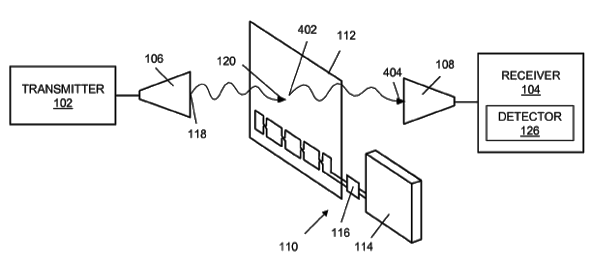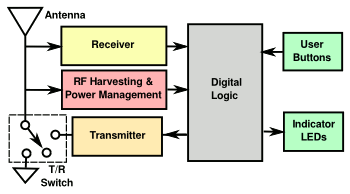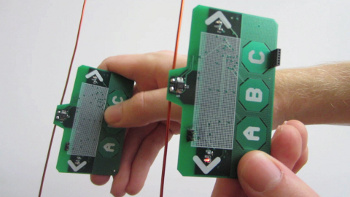Revel in the Ambiance
August 30, 2013
When you read a traditional (
paper and
ink)
book, you're making use of an ambient
electromagnetic field. The
Sun, or a
lamp, is providing
photons indiscriminately to
illuminate your space, and you're making use of the small fraction that
reflect from the page and reach your
eyes. When you're reading by sunlight, it's about as close to a
free lunch as you can get.
When you read, you make use of the ambient
radiation in the
visible spectrum, but the Sun also provides plenty of invisible
infrared and
ultraviolet radiation. The Sun's infrared and ultraviolet are the most intense of the invisible ambient radiation, but
nature provides other sources.
There are natural processes, such as
lightning, that provide ambient radiation at
radio wavelengths. The
human body, itself, glows brightly at about
100 GHz, and this fact is used as the basis for
millimeter wave security scanners. Although the Sun is surprisingly quiet at radio frequencies,
other objects in the
universe produce radio waves detected by
radio astronomers.
As I wrote in a
previous article (Harvesting Radio Frequency Energy, November 22, 2011), modern
technology has enhanced the glow of the ambient radio spectrum to the point at which it's possible to
harvest this
energy to power small
electronic devices. Useful energy can be harvested from
radio and
television broadcasting stations, and it's locally generated by
Wi-Fi devices in our homes and offices. Just a few months ago, I wrote about research at the
University of Washington computer scientists on
gesture recognition using ambient Wi-Fi radiation (
Gesture Recognition, June 17, 2013).[1-2]
Not exactly ambient field devices, but close
cousins, are
RFID devices. These are like ambient field devices, but they differ in the fact that the external field is purposefully generated, typically at a fixed
frequency. RFID devices are designed to harvest energy at that frequency to energize their electronics, which often include a
transmitter.
The idea of using generated and ambient fields to power devices has been around for quite some time. The most interesting example is an invention by
electronic music pioneer,
Léon Theremin.
Theremin's invention, was a
covert listening device embedded in a
wood carving of the
Great Seal of the United States. The seal was a wall decoration in the
US ambassador's Moscow home.
Theremin's device incorporated a
quarter-wavelength antenna excited by a
carrier wave from a remote
transmitter operating at about 330
MHz. This carrier wave was
phase modulated by a
condenser microphone, and speech signals were detected at a remote
receiver. More information on this device can be found in my previous article,
Cyber Warfare, November 10, 2011.

Even I've dabbled in passive RF communications. This is figure four of my January 29, 2013, patent, "Modulated antenna for wireless communications." In this case, I'm modulating an ambient radio frequency field using a Sterba Curtain antenna. (US Patent No. 8,362,961, via Google Patents.)[3)]
Some of the same University of Washington
engineers who did the Wi-Fi gesture recognition research mentioned above have just published details of an ambient backscatter device at the
Association for Computing Machinery's Special Interest Group on Data Communication (SIGCOMM) 2013 conference in
Hong Kong.[5] The research team received the best-paper award at that conference.[5]
These ambient backscatter devices operate by harvesting ambient RF energy for power, and then
absorbing or reflecting these pre-existing radio signals for
communication.[5] Such devices need no
battery power and no human attention. Says
Shyam Gollakota, an
assistant professor of
computer science and engineering at the University of Washington and team leader,
"We can repurpose wireless signals that are already around us into both a source of power and a communication medium... It's hopefully going to have applications in a number of areas including wearable computing, smart homes and self-sustaining sensor networks."[5]
A
block diagram of an example ambient backscatter device is shown in the figure.

Block diagram of an RF ambient backscatter device.
(Modified version of fig. 3 of ref. 4, rendered using Inkscape.)[4)]
One important application for such devices is for communication with
structural health sensors embedded into structures. Such sensors could communicate the presence of a
crack.
Credit-card sized
proof-of-concept devices were constructed and tested in the
Seattle area at locations ranging from about a half
mile to six and a half miles distant from a television tower (see photograph).[5]

Credit-card sized proof-of-concept ambient backscatter devices.
(University of Washington photograph.)
These devices could communicate at a
data rate of a
kilobit per second over a range of 2.5
feet outdoors, where the ambient signals were stronger, and 1.5 feet indoors, where the ambient signals were weaker.[5] This was more than enough to light a
light-emitting diode associated with a particular button press and transfer "funds" from one credit card to another, as shown in a
YouTube video.[5-6]
The research was funded by a
Google Faculty Research Award and by the
National Science Foundation's Research Center for Sensorimotor Neural Engineering at the University of Washington.[5]
References:
- Michelle Ma, "Wi-Fi signals enable gesture recognition throughout entire home," University of Washington Press Release, June 4, 2013.
- Whole-Home Gesture Recognition Using Wireless Web Site at the University of Washington.
- Devlin M. Gualtieri, "Modulated antenna for wireless communications," US Patent No. 8,362,961, January 29, 2013.
- Vincent Liu, Aaron Parks, Vamsi Talla, Shyamnath Gollakota, David Wetherall and Joshua R. Smith, "Ambient Backscatter: Wireless Communication Out of Thin Air," Paper Prepared for SIGCOMM'13, August 12–16, 2013, Hong Kong, China.
- Michelle Ma, "Wireless devices go battery-free with new communication technique," University of Washington Press Release, August 13, 2013.
- University of Washington Ambient Backscatter Devices, YouTube Video.
Permanent Link to this article
Linked Keywords: Paper; ink; book; electromagnetic field; Sun; lamp; photon; lighting; illumination; reflection; eyes; free lunch; electromagnetic radiation; visible spectrum; infrared; ultraviolet; nature; lightning; radio; wavelength; human body; millimeter wave; 100 GHz; millimeter wave security scanner; radio galaxy; universe; radio astronomer; technology; energy harvesting; energy; electronics; electronic device; radio broadcasting; radio; television; broadcasting station; Wi-Fi; University of Washington; computer scientist; gesture recognition; cousin; radio-frequency identification; RFID device; frequency; transmitter; electronic music; Léon Theremin; covert listening device; wood carving; Great Seal of the United States; US ambassador; Moscow; quarter-wavelength antenna; carrier wave; transmitter; hertz; MHz; phase modulation; phase modulated; condenser microphone; receiver; Sterba Curtain antenna; engineer; Association for Computing Machinery's Special Interest Group on Data Communication (SIGCOMM) 2013 conference; Hong Kong; absorption of electromagnetic radiation; telecommunication; communication; battery; Shyam Gollakota; assistant professor; computer science and engineering; block diagram; Inkscape; structural health monitoring; structural health sensor; fracture; crack; credit-card; proof-of-concept; Seattle; mile; data rate; bit rate; kilobit per second; foot; light-emitting diode; YouTube video; Google Faculty Research Award; National Science Foundation; Research Center for Sensorimotor Neural Engineering; Devlin M. Gualtieri, "Modulated antenna for wireless communications," US Patent No. 8,362,961, January 29, 2013.